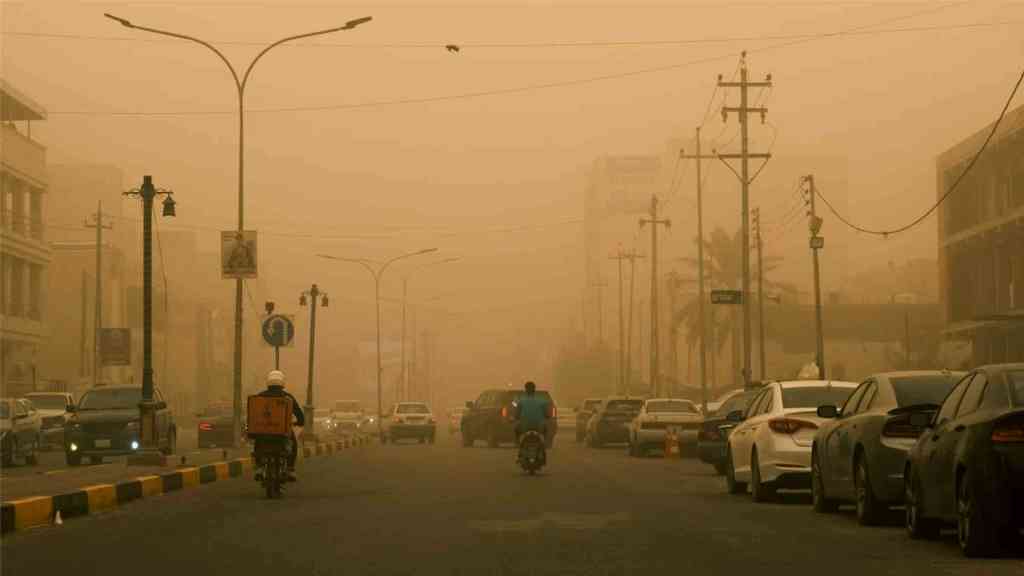Like tsunamis in the sky, sandstorms produce dense clouds of dust and particles that bury everything below.
Even a small brush with a sandstorm is unpleasant, causing eyes and skin to itch and making breathing more difficult. Inhaling too many sand and dust particles can even be life-threatening.
So where do they come from?
When strong winds blow over bare or sparsely vegetated ground, they whirl up dry earth, sand and dust, lifting it through the air.
This often creates huge dust storms. Some churned-up particles fall back to the ground, but the smaller ones are often transported to great heights and carried further — sometimes even thousands of kilometers — by air currents.
According to the United Nations, around 2 billion tons of sand and dust are stirred into the atmosphere every year up to a height of around 12 kilometers (7.5 miles). Roughly a quarter of this ends up in the oceans.

Half of all the sand in the air originally comes from the Sahara, the rest from other deserts and arid regions. The so-called “dust belt” of our planet stretches from the Sahara through the Middle East to the deserts of Central and Northeast Asia.
If sand is blown in from the Sahara, its color gives away its region of origin. In the western Sahara, sand is usually red or brown, whereas in the east and south, it tends to be yellowish or white.
Are sandstorms important for our ecosystems?
Desert sand comprises organic and inorganic substances, including many nutrients and minerals.
Saharan dust that blows all the way to the South American rainforest and the Caribbean is an important mineral fertilizer. The well-traveled sand settles on the ground and helps compensate for nutrient-poor soil in these regions.
Desert dust is also an extremely important ocean fertilizer, providing the basis for the food chains in our seas. For example, corals like the Great Barrier Reef use dust and sand particles to build their skeletons.

However, too much sand and dust can also be harmful.
Scientists suspect it could lead to more algae growth in our oceans. If excessive, this can deprive the water of oxygen, killing marine life. Microorganisms contained in the desert dust may also be behind various coral diseases.
Why are there more and more sandstorms?
While dust and sandstorms have always occurred, their frequency doubled in some areas of the world in the 20th century.
According to the UN, at least a quarter of global dust emissions can be attributed to human activity, mainly due to the misuse of land and water.
The World Meteorological Organization (WMO) says around half the dust in the atmosphere comes from soil that has been damaged by deforestation, agricultural or industrial cultivation, droughts and heavy rainfall. Winds can easily whip up such disturbed soil.

What impact is this having on our health and climate?
While dust and sandstorms are environmentally important, their increase has negative effects.
Sandstorms can cause heart and respiratory diseases, eye and skin irritation, and spread infections like meningitis.
This is because desert dust can contain various microorganisms, such as fungi, bacteria and viruses. Sandstorms regularly affect air traffic, remove fertile soil from fields and destroy harvests.
They can also influence our weather, as water collects around the solid dust particles, causing more clouds to form. However, they also reduce precipitation, as the presence of solid dust means it takes longer for large droplets of water to form.
Creating more cloud coverage can also reduce solar radiation, and a higher concentration of dust particles in the atmosphere can influence the distribution of cyclones around the world.

What can we do to combat sandstorms?
According to the UN Convention to Combat Desertification (UNCCD), sandstorms are still underestimated as a disaster risk in many places.
To prevent their increase, the UNCCD says we need to start taking better care of our soil by protecting it from drying out and increasing its fertility.
Achieving this requires a reduction in open, unvegetated land through reforestation and more sustainable groundwater use. In areas where livestock is kept, it will also help to ensure animals are rotated between plots so plants can grow back on grazed land.
Edited by: Anke Rasper
This article was originally published in German.
Sources:
https://community.wmo.int/en/sds-anthropogenic-impact
World Meteorological Organization, reasons for sandstorms
https://www.unep.org/resources/report/impacts-sand-and-dust-storms-oceans
United Nations Environmental Program, Influence of sandstorms on oceans



